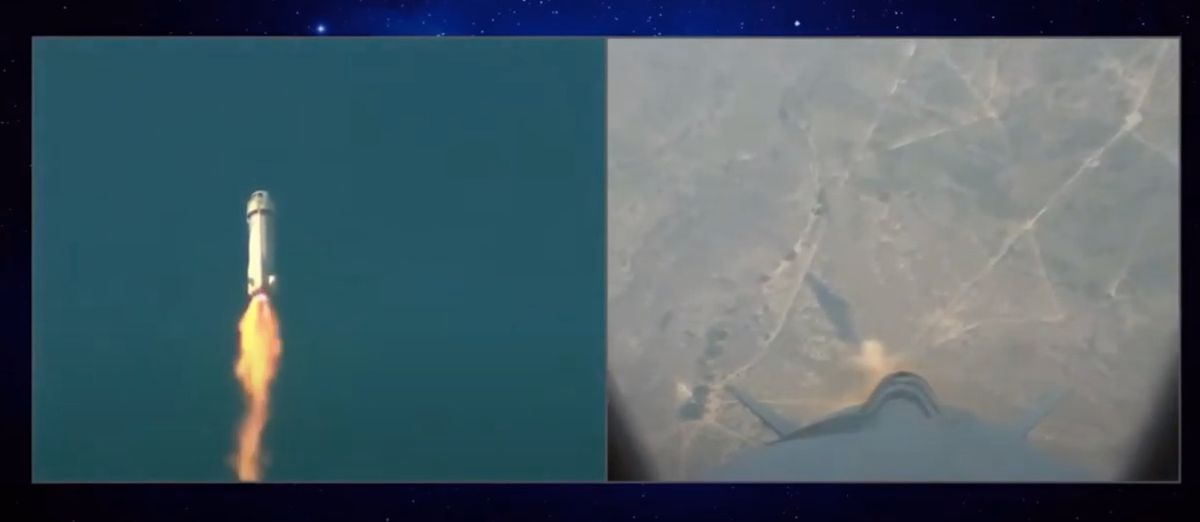
The failure of an uncrewed Blue Origin mission today (Sept. 12) provides an object lesson to space fans and casual observers alike: spaceflight is still hard.
Blue Origin launched its New Shepard vehicle on an uncrewed science mission to suborbital space this morning from West Texas. New Shepard's first-stage booster suffered an anomaly about a minute into the flight, spurring the vehicle's capsule to engage its emergency escape system. The capsule got itself away from trouble and landed safely under parachutes, and the booster hit the ground and was presumably destroyed.
It was the first serious problem for New Shepard since the suborbital vehicle's first-ever spaceflight, in April 2015. On that debut mission, the New Shepard booster crashed during its touchdown attempt, though everything else went well.
Space travel: Danger at every phase (infographic)
After that, the reusable New Shepard flew flawlessly 21 times in a row, carrying space tourists safely to the final frontier and back on six of those missions. It seemed that Blue Origin had suborbital flight figured out, that future missions would always run like clockwork — until today.
In-flight failures are always startling, given the dramatic visuals that accompany them and the investment of time and money that each one incinerates. But the possibility of failure should always be in the back of our minds.
Rockets are complex machines riding controlled explosions high into the sky, and the slightest problem can knock "controlled" out of that equation. The spacecraft side of things is no picnic, either; the space environment is harsh, and vehicles coming back to Earth experience extremes of velocity and temperature that can expose the slightest design or manufacturing flaw, sometimes to tragic effect.
Think of NASA's iconic space shuttle program. It suffered catastrophic failures during two of its 135 missions, killing 14 astronauts. One of those tragedies — the Challenger explosion, in January 1986 — occurred during launch. The other — Columbia, in February 2003 — took place when the orbiter was coming home to Earth.
This is not to pick on the shuttle program; we could cite many other incidents to make the same point. One of Astra's rockets failed in June, for example, resulting in the loss of two hurricane-studying NASA cubesats. And the lengthy list of 2021 mishaps includes launch failures by Rocket Lab's Electron booster and India's Geosynchronous Satellite Launch Vehicle, as well as Russia's Kosmos 2551 spy satellite, which failed to adjust its orbit properly after a smooth liftoff.
Related stories:
To be clear: These are not one-to-one comparisons with today's New Shepard incident. Going orbital requires much higher energies, and is therefore significantly more difficult, than topping out at suborbital altitudes. But no category of spaceflight is easy.
It's too soon to say how today's New Shepard anomaly will affect Blue Origin and space tourism in general going forward; such questions must wait until Blue Origin figures out what went wrong and how to fix it. (The company uses different New Shepard vehicles to launch uncrewed and tourist flights, it's important to note.)
But we can take one lesson from today's events. Let's cheer a little more enthusiastically when a rocket makes it to space and a mission — even one that "only" goes suborbital — ends successfully. Let's not be cynical or blasé. Space is still hard, and getting there and back remains something to celebrate.
Mike Wall is the author of "Out There (opens in new tab)" (Grand Central Publishing, 2018; illustrated by Karl Tate), a book about the search for alien life. Follow him on Twitter @michaeldwall. Follow us on Twitter @Spacedotcom or on Facebook.
The Link LonkSeptember 13, 2022 at 02:29AM
https://www.space.com/blue-origin-failure-reminder-spaceflight-hard
Failure of Blue Origin's New Shepard a reminder that spaceflight is still hard - Space.com
https://news.google.com/search?q=hard&hl=en-US&gl=US&ceid=US:en
No comments:
Post a Comment